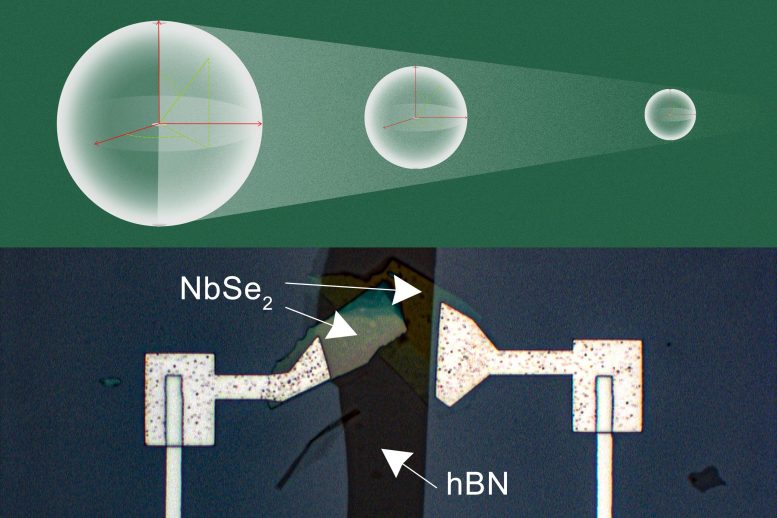
Using ultrathin materials to reduce the size of superconducting qubits may pave the way for personal-sized quantum devices.
Like the transistors in a classical computer, superconducting qubits are the building blocks of a quantum computer. While engineers have been able to shrink transistors to nanometer scales, however, superconducting qubits are still measured in millimeters. This is one reason a practical

MIT researchers used the 2D material hexagonal boron nitride to build much smaller capacitors for superconducting qubits, enabling them to shrink the footprint of a qubit by two orders of magnitude without sacrificing performance. Credit: Figure courtesy of the researcher; edited by Christine Daniloff and Jose-Luis Olivares, MIT
“Right now, we can have maybe 50 or 100 qubits in a device, but for practical use in the future, we will need thousands or millions of qubits in a device. So, it will be very important to miniaturize the size of each individual qubit and at the same time avoid the unwanted cross-talk between these hundreds of thousands of qubits. This is one of the very few materials we found that can be used in this kind of construction,” says co-lead author Joel Wang, a research scientist in the Engineering Quantum Systems group of the MIT Research Laboratory for Electronics.
Wang’s co-lead author is Megan Yamoah ’20, a former student in the Engineering Quantum Systems group who is currently studying at Oxford University on a Rhodes Scholarship. Pablo Jarillo-Herrero, the Cecil and Ida Green Professor of Physics, is a corresponding author, and the senior author is William D. Oliver, a professor of electrical engineering and computer science and of physics, an MIT Lincoln Laboratory Fellow, director of the Center for Quantum Engineering, and associate director of the Research Laboratory of Electronics. The research was published on January 27, 2022, in Nature Materials.
Qubit quandaries
Superconducting qubits, a particular kind of quantum computing platform that uses superconducting circuits, contain inductors and capacitors. Just like in a radio or other electronic device, these capacitors store the electric field energy. A capacitor is often built like a sandwich, with metal plates on either side of an insulating, or dielectric, material.
But unlike a radio, superconducting quantum computers operate at super-cold temperatures — less than 0.02 degrees above


Thanks for the feedback! That’s an interesting point. I suppose there are many reasons, internal and external, why we do not accomplish all that we might. Regardless, I am thankful for the Lord’s grace in that. Thanks again!
sms onay hizmetine sitemizden göz atabilirsiniz.
merhaba sitemizi ziyaret edebilir ve kuşadası escort hizmetinden faydalanabilirsiniz.
sitemizi ziyaret etmek için url tıklamanız yetreli olucaktır
en iyi escort seçmek için hızlıca ulaşın
otele gelen ucuz escort bayan ile tıklayın
ucuz vip ulaşabilceğin escort bayan
arabada görüşen escort için tıkla
arabada ucuz veren escort burada tıkla ve ulaş ona
en iyi balık etli escort burada tıkla ulaş ona
merkezde ucuz escort bulmak için sadece tıklayın
en iyisinde güzel rus escort bayan
en iyi kaliteli escort bayan burada
kaliteli yerli escort bulmak için tıklaman yeterli olacaktır sadece
eve otele gelen tek escort burada vip escort tıkla ulaş ona